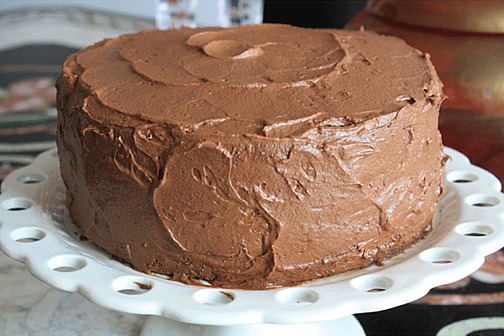
Photo and cake by Sarah Phillips © Sarah Phillips
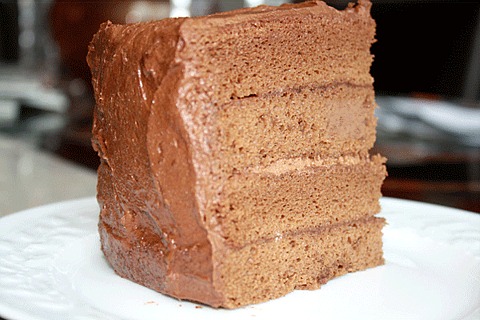
Photo and cake by Sarah Phillips © Sarah Phillips
Premium Member, Little Island, asked me for a chocolaty Chiffon Cake, which I invented for her, when she complained that most chocolate chiffon cakes are not chocolaty enough. I tested it out when Kelly and her family came to visit me in New York from California, in late June. I made the cake for her 50th birthday (July 22), with two layers filled with raspberry jam and one with Nutella. I decided to frost the cake with my Chocolate Fudge Buttercream Ganache Frosting. The cake fit the bill as it was chocolaty and moist and very flavorful! It was a difficult cake to create because foam cakes are difficult to impart a lot flavor from and this one hit the nail on the head! It's a nice lofty cake, too, and the layers have a nice height and density.
CAKE RECIPE HELP
INGREDIENTS
12 large eggs, separated; (You'll need 12 egg yolks and 12 egg whites for the recipe)
1 3/4 cups bleached cake flour, spoon into measuring cup and level to rim
1/2 cup NATURAL cocoa powder
1 1/2 cups sugar; divided in 3/4 cup and 3/4 cup
2 teaspoons baking powder
1/4 teaspoon baking soda
1/2 teaspoons salt
2/3 cup oil
3/4 cup cold tap water
2 teaspoons vanilla
2 ounces bittersweet chocolate, melted and cooled
1/4 teaspoon cream of tartar
INSTRUCTIONS
1. Preheat the oven and prepare the baking pans:
A. Position the oven rack in the middle of the oven and preheat the oven to 325 degrees F.
SARAH SAYS: In my oven, the center rack is the third rung up. When you have an even number of racks, and have to choose as to whether the third or fourth rack up is the middle, as I do in my oven, when in doubt, go to the lower rack of the two.
B. Prepare two 9 x 2-inch baking pans. Set aside:
SARAH SAYS: DO NOT use a non stick pan. The cake needs to be inverted to cool. You don't want the cake to fall out of the pan which it will with a non-stick one. For light-colored cake sides, use a light, heavy aluminum pan, not a dark-colored one.
1. Place one pan on top of a piece of parchment paper and trace around it with a pencil. The lead is nontoxic.
Cut out the round of parchment paper following the pencil marks as a guide.
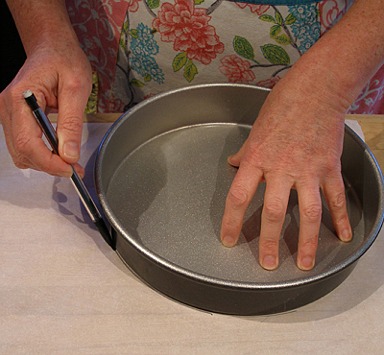
2. With melted butter or vegetable oil, lightly grease the bottom of the pan ONLY. Use a pastry brush. Do NOT grease the side of the pan.
Foam cakes, such as this, need to cling to the side of the pan in order to rise properly.
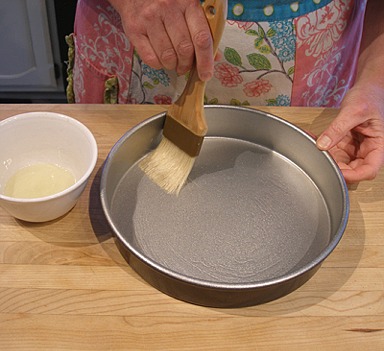
3. Place the parchment paper round on top of the greased pan bottom.
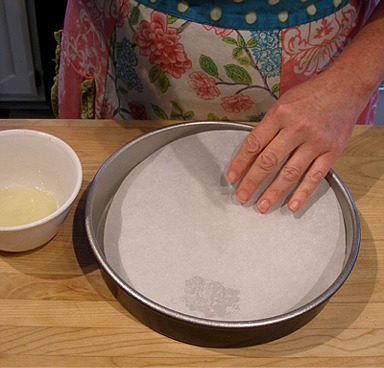
4. Grease the bottom of the parchment paper round with melted butter or vegetable oil with a pastry brush. Do NOT grease the side of the pan.
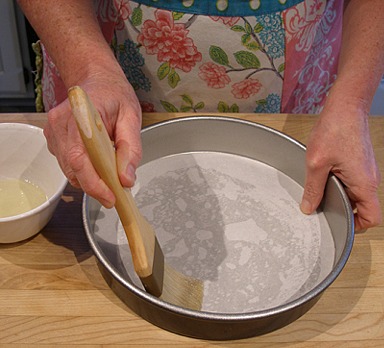
5. Repeat with the second pan.
2. Make the cake batter:
A. Combine the dry ingredients:
1. In large mixing bowl, preferably with a wide rim, sift together the flour, cocoa powder, baking powder, baking soda and salt. If you don’t have a sifter, use a fine mesh strainer. Repeat two more times.
2. Add 3/4 sugar and whisk together to blend. Make a well in the center of the flour mixture and set aside.
B. Prepare the batter mixture:
SARAH SAYS: In the well of the flour mixture, add the following, in order WITHOUT mixing.
1. Add the oil
2. Add the 12 egg yolks;
3. And, finally, the water and vanilla extract
4. Add in the cooled and melted chocolate: in a small bowl, place a few tablespoons batter. Add a large tablespoon of melted and cooled chocolate to it and stir.
5. Add the rest of the melted chocolate to the small bowl of batter and mix. Add both back into the main batter.
SARAH SAYS: The reason for layering the ingredients in a certain order before mixing helps form the batter properly. I have found, through my extensive testing of a wide variety of Chiffon Cake Recipes, that some failed while others didn't. I set out to find out why. I found that one of the biggest causes of failed Chiffon Cakes, besides the improper beating of egg whites and not properly folding the recipe together, is ALSO the improper formation of the cake batter (not written about anywhere — yes, you heard it here first!) Many recipes have you simply dump all of the batter's ingredients into the bowl without regard to order or mixing method, which you'll observe if you look through most cookbooks, leading to many failed recipes and unhappy bakers.
C. Mix and strain the batter ingredients:
1. With a wire whisk, mix together the batter ingredients until smooth.
2. Strain the batter mixture through a fine mesh strainer by pushing the mixture through with the help of a rubber spatula to a large bowl below. Discard any flour lumps that are left in the strainer.
SARAH SAYS: It is critical that the resulting batter mixture is smooth and without lumps because when the cake bakes, the flour lumps will stay that way.
HELP! I had to throw away a lot of flour lumps. I'm worried that there isn't enough flour left for the recipe. What should I do?
CRAFTYBAKING RESCUE: ONLY if there is a tablespoon or MORE of flour lumps left in the strainer, sift a tablespoon of flour on top of the mixture and stir. But, be careful you don't get into the vicious cycle of adding flour and then straining the batter mixture.
3. Beat the 12 egg whites until they are stiff and glossy: Use a stand mixer when you have a large amount of whites to beat, such as this recipe.
A. Place egg whites in a clean, dry grease-free mixer bowl of a stand mixer. Make sure there are no egg shells in the mixture.
SARAH SAYS: You can whip the egg whites if they are still cold. The real issue with egg whites is their freshness, not temperature, so you can beat whites right from the refrigerator, althought they may require slightly more beating time. Newer fresh eggs have thicker whites and will reach more volume and have greater stability when beaten than older eggs.
B. With a stand mixer fitted with a whisk attachment, beat egg whites on low until foamy.
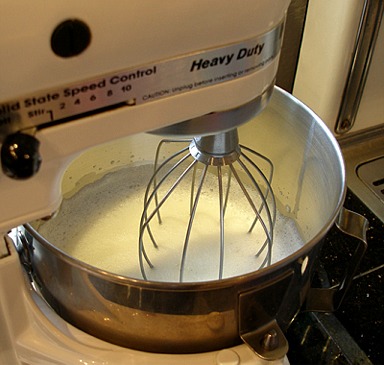
SARAH SAYS: As air is beaten into the egg whites, they will start to lighten in color. This beginning step is one of the most overlooked and important steps. If egg whites are beaten too quickly at the beginning, the structure of the foam will not be as strong, and later the egg whites will not beat as high as they should.
Keep mixing the egg whites on low speed. The egg white foam will increase in volume and become white and have large bubbles.
C. With the mixer running, immediately add the cream of tartar at the side of the bowl.
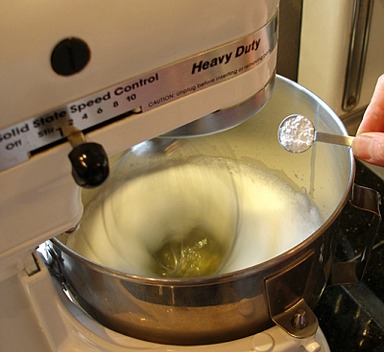
SARAH SAYS: Adding a small amount of acid, such as cream of tartar, lemon juice or vinegar, stabilizes egg whites and allows them to reach their full volume and stiffness. It does this by making the egg coagulate faster.
D. The bubbles in the egg white foam will become smaller and more even in size. When it reaches this stage, increase the mixer speed to medium-high.
E. Then, add 3/4 cup sugar slowly in a steady stream at the side of the bowl. After the sugar has been added, increase the mixer speed to high.
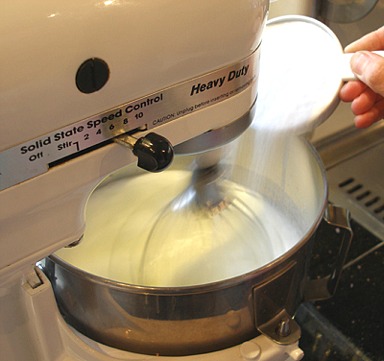
SARAH SAYS: Always add sugar in a stream, slowly at the side of the bowl while the whites are being whipped; do not dump it in the center — you don't want to risk deflating the whites.
SARAH SAYS: I stopped the mixer so you could see how the egg white foam is beginning to become glossy. This is called the soft peak stage. It is reached when the peaks of the whites droop slightly, when the beater is turned off and lifted.
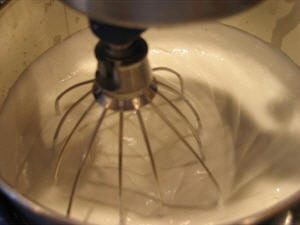
But, this recipe calls for beating the whites to the stiff peak stage…so keep beating with the mixer on high.
F. Beat until the egg whites are white, fluffy, very stiff and still very glossy.
For this recipe, the whites should be stiffer than most. They will form lumps as the mixer beats. STOP beating when they start to form lumps around the beater as shown in the photo.
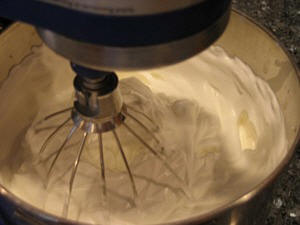
To test if properly beaten to the stiffly beaten stage, take the mixer bowl from the mixer or lift the beaters. You can gently cut a table or icing knife through the middle of the beaten egg whites; it creates a narrow grove with stiff walls. If not, continue beating for a few seconds more and perform the test, again.
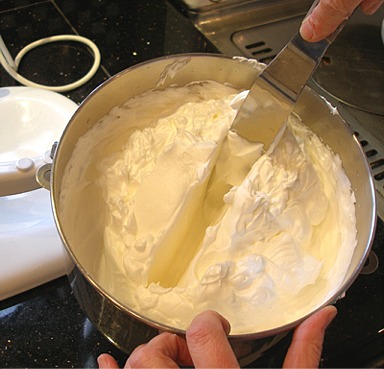
SARAH SAYS: Another test to perform to see if your egg whites are stiffly beaten are to stop the beaters and then lift them — straight and stiff peaks should form.
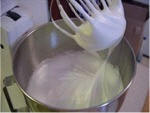
4. Fold the egg whites and the batter mixture until thoroughly blended
SARAH SAYS: When you fold the batter and beaten egg whites together, they must be thoroughly blended; you need to make sure all of the air bubbles are encased in batter, otherwise the cake won't rise properly. The batter will set around the air bubbles when the cake bakes in the oven, allowing it to puff properly. In essence, the folding action breaks up the air bubbles into smaller ones and encases each one in batter, like putting mortar in between small tiles to hold them in place.
A. To start, use the batter mixture that was previously set aside. Stir it a few times to mix it thoroughly before using.
With a large rubber spatula, gently scrape 1/3 of the beaten egg whites on top of the mixture. Never add the batter to the whipped whites or the heavier mixture on top of the lighter, beaten they'll deflate.
B. With the rubber spatula, in a large circular sweeping motion as if you are turning a crank, lightly combine the egg whites and batter. Do this one or two times. Be sure to scrape the bottom of the bowl.
C. Starting on the top, cut down from the center of the mixture to the bottom of the bowl, then draw the scraper quickly towards yourself against the edge of it, and up to the left and out. You are thus bringing a bit of the mixture at the bottom of the pan up over the egg whites or “folding it over”. Then turn the bowl a quarter turn and repeat until you only see slight streaks of white. You will need to scrape the sides of the bowl a few times to keep the mixture from climbing up the sides.
D. Repeat with the last two additions.
E. Continue the folding movement while slowly rotating the bowl, and cutting down, towards yourself, and out to the left, until the egg whites have been folded into the body of the batter. You shouldn't see any streaks of batter and eggs whites in the mixture. The mixture should be smooth. Sometimes you'll see with a few small lumps visible; it just means that you slightly overwhipped the egg whites. Do not continue to fold the mixture because you'll start to remove the air from the batter.
5. Bake the cake layers:
A. Immediately scrape the batter equally into the prepared pans. The batter will fill close to the top of the pan. Run a table knife or thin icing spatula through the batter in an “s” formation so large air pockets will break-up into smaller ones. It will also break up any egg white clumps. The rest will dissolve into the batter. DO NOT bang the pan on the countertop – to me, it is the same as slapping someone on the back with an open hand, leaving them without air; it's a harsh movement — you'll remove too much air from the batter if you do!
B. Run a table knife or thin icing spatula through the batters in an “s” formation so large air pockets will break-up into smaller ones. It will also break up any egg white clumps. The rest will dissolve into the batter. DO NOT bang the pans on the countertop because this eliminates air from the batter, which you don't want to do!
C. Gently smooth the tops with a rubber spatula. Clean off the extra batter on the sides of the pans with a wet paper towel.
D. Immediately place the filled pans in the middle shelf in a well-preheated oven.
E. Bake for 40 to 45 minutes or until the cake springs back when touched lightly with the open palm of your hand – avoid poking the cake because you'll create dents. Insert a toothpick in the center and it should come out with no batter attached or perhaps a tiny moist crumb or two. The top will develop some surface cracks during baking – it is normal. Do NOT overbake or the cake will start to shrink from the sides of the pan and taste eggy.
6. Cool the cake in its cake pan on a wire cake rack. DO NOT INVERT the cake layer in its pan for THIS cake recipe.
When cool, run a knife around the edge of the pan and unmold. Remove the parchment paper and set upright.
STORAGE
The cake will keep for about 3 days at room temperature, and 10 days refrigerated. Refrigerate if filled or frosted with perishable items, where it will keep for a few days because the filling and frosting only lasts that long. Chiffon cakes can be frozen for two months or so, but suffer somewhat in texture when thawed. It's best to freeze cake before unmolding from the pan. Wrap pan in foil before doing so.
VARIATIONS
Moist Very Chocolaty Chiffon Cake – one layer
Makes one 9- x 2-inch cake layer
INGREDIENTS
6 large eggs, separated
3/4 + 1/8 cups bleached cake flour, spoon into measuring cup and level to rim
1/4 cup NATURAL cocoa powder
3/4 cups sugar; divided; use 6 tablespoons (1/4 + 1/8 cups) and 6 tablespoons (1/4 + 1/8 cups)
1 teaspoons baking powder
1/8 teaspoon baking soda
1/4 teaspoons salt
1/3 cup oil
1/4 + 1/8 cup cold tap water
1 teaspoons vanilla
1 ounce bittersweet chocolate, melted and cooled
1/8 teaspoon cream of tartar
INSTRUCTIONS
Bake at 325 degrees F in one, 9 x 2-inch pan for about 30 to 40 minutes.


